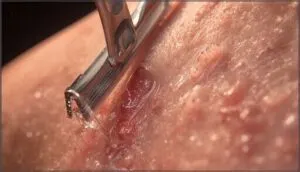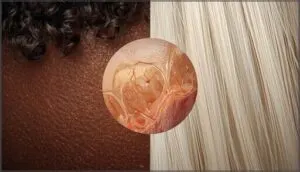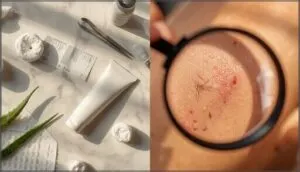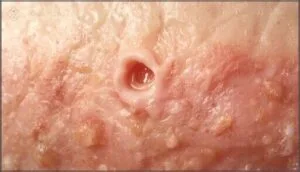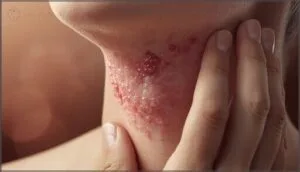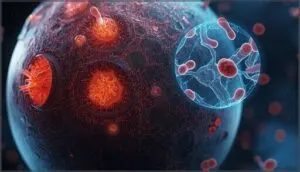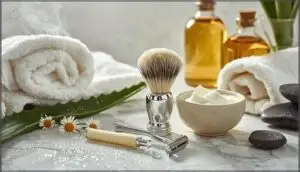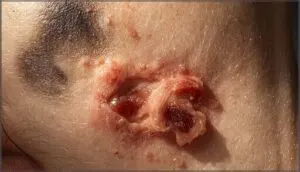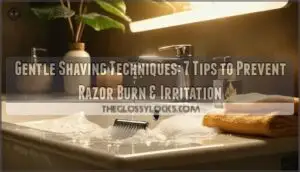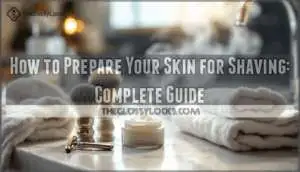This site is supported by our readers. We may earn a commission, at no cost to you, if you purchase through links.
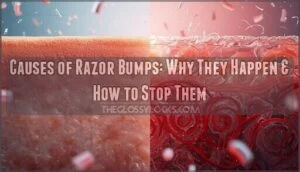
You reach for your razor, follow your usual routine, and a day later your skin erupts in angry red bumps that itch, burn, and refuse to disappear. This frustrating cycle affects up to 60% of Black men and 15% of all people who shave regularly.
The causes of razor bumps on skin trace back to a deceptively simple problem: when you cut hair at or below the skin’s surface, it sometimes grows back into the skin instead of out of it. Your hair shaft curls back on itself, pierces the follicle wall, and triggers an inflammatory response that creates those characteristic papules.
Understanding this process—and the specific factors that make your skin more vulnerable—gives you the power to break the cycle and reclaim smooth, bump-free skin.
Table Of Contents
- Key Takeaways
- What Are Razor Bumps?
- How Shaving Causes Razor Bumps
- The Role of Ingrown Hairs
- Hair Type and Skin Tone Risk Factors
- Other Hair Removal Methods and Risks
- Skin Conditions That Contribute
- Recognizing Razor Bump Symptoms
- Preventing Razor Bumps
- Treating Existing Razor Bumps
- Complications From Untreated Razor Bumps
- Frequently Asked Questions (FAQs)
- Conclusion
Key Takeaways
- Razor bumps occur when cut hair curls back and pierces your skin, triggering inflammation—a problem affecting up to 60% of Black men and significantly linked to curly or coarse hair texture that increases ingrown hair risk by up to 50 times compared to straight hair.
- Your shaving technique directly determines whether bumps form: going against the grain raises your risk by 58%, while shaving with hair growth, using sharp single-blade razors, and proper pre-shave prep can reduce irritation by 30-40%.
- Left untreated, razor bumps don’t just fade—they lead to permanent hyperpigmentation in up to 78% of darker-skinned patients and can progress to scarring or keloids in 90% of persistent cases, especially with repeated shaving trauma.
- Prevention requires a multi-step approach combining regular exfoliation (reducing bumps by 34-42%), post-shave moisturizing, and when needed, medical treatments like retinoids or laser hair removal that can reduce hair density by over 50% for long-term relief.
What Are Razor Bumps?
Razor bumps show up as small, inflamed bumps on your skin after you shave or remove hair. They’re not just a cosmetic annoyance—they can itch, hurt, and even lead to darker spots or scars if you don’t address them.
Let’s break down what they are, where they commonly appear, and how they’re different from other common skin problems.
Definition of Razor Bumps
Razor bumps, known in medical terminology as pseudofolliculitis barbae, are small inflamed lesions that form when shaved hair curves back into your skin. This hair re-entry triggers an inflammatory response, creating:
- Skin-colored or red papules (2 to 5 mm)
- Itchy, tender bumps
- Potential pustules with infection
Unlike folliculitis barbae, which involves bacterial infection, razor bumps stem from ingrown hairs—a key differential diagnosis factor. Proper shaving techniques can help prevent skin irritation.
Common Locations on The Body
These bumps develop wherever you remove hair, but certain zones see much higher rates. The beard area and neck take the lead—up to 60% of Black men experience razor bumps here, with the submandibular region affected in nearly 70% of cases.
Your pubic area, legs, and axilla (armpits) are also vulnerable, especially with frequent shaving. Even scalp shaving can trigger these inflamed papules.
It’s important to tell them apart from potential STDs.
How Razor Bumps Differ From Other Skin Issues
You might mistake razor bumps for acne, folliculitis, contact dermatitis, or even STDs—but clinical features set them apart. Differential diagnoses hinge on timing and location: razor bumps appear days after shaving, strictly where hair’s removed.
Acne shows blackheads and cysts in oil-prone zones. Folliculitis barbae involves broader skin infection. Contact dermatitis spreads beyond shaved areas with oozing blisters.
Scarring variations also differ—razor bumps risk keloids and hyperpigmentation unique to this condition.
How Shaving Causes Razor Bumps
Shaving seems straightforward, but the process can traumatize your skin in ways that lead directly to razor bumps. The blade’s interaction with your skin and hair creates conditions for inflammation and ingrown hairs.
Three specific shaving factors contribute most to this problem.
Shaving Techniques and Skin Trauma
The way you shave directly impacts whether your skin stays smooth or erupts in angry bumps. Even the best blade sharpness won’t save you from skin trauma if your technique is off. Here’s what drives irritation:
- Shaving Direction — Going against the grain increases inflammation and razor bump causes by forcing hairs to re-enter skin.
- Pre-Shave Prep — Dry shaving drags and tears at follicles, triggering immediate redness in over half of shavers.
- Post-Shave Care — Skipping soothing products leaves skin vulnerable to infection and prolonged irritation.
Your razor type and shaving techniques matter as much as the products you use.
Effects of Dull or Dirty Razors
Using a blade beyond its prime does more than provide a mediocre shave—it sets the stage for infection risks and pathogen transmission. Dull or dirty razors scrape your skin, amplifying skin irritation and ingrown hairs.
Studies show infection rates jump to 5.6% after using contaminated blades, compared to 0.6% with proper hygiene. Your razor’s condition directly influences razor bump causes and overall shaving effectiveness.
Shaving Direction and Skin Irritation
Why does the direction of your stroke matter so much? Shaving against hair growth ranks among the top causes of razor bumps. Studies reveal 58% of people who routinely go against the grain battle frequent outbreaks. Here’s what dermatological guidelines emphasize:
- Grain shaving with hair growth cuts follicular trauma by 40%
- Against-the-grain shaving traps hairs below skin in 60% of cases
- Pressure magnitude correlates directly with skin irritation after shaving (0.76 correlation)
- Hair training with daily brushing reduces new bumps by 50%
- Proper shaving techniques lower pseudofolliculitis barbae diagnoses by 55%
The Role of Ingrown Hairs
Ingrown hairs are the main culprit behind razor bumps, and understanding how they form gives you the power to prevent them. When hair doesn’t grow out of your skin the way it should, it triggers inflammation and those frustrating red bumps.
Let’s look at why some hairs get trapped beneath the surface while others grow normally.
Hair Growth Patterns
Hair follicles don’t all grow at the same angle—follicle direction varies by region on your body, and those differences matter. In areas with multidirectional growth patterns, such as the jawline or neck, hair may emerge in circular or irregular orientations, making it more likely to curl back or pierce nearby skin.
Curly hair and coarse hair naturally follow a curved trajectory beneath the surface, increasing the risk of razor bumps. Ethnic variability plays a role here; individuals with tightly coiled follicles often experience a mismatch between the visible hair angle and its deeper path.
How Hairs Become Ingrown
When your hair shaft curves or twists after shaving, it can pierce the skin surface or re-enter the follicle wall instead of growing outward. Curly hair is especially prone to this loop-shaped trajectory.
Dead skin and debris clog the follicle opening, trapping the growing hair beneath the surface. That trapped strand triggers inflammation—redness, bumps, and irritation follow quickly.
Follicle Structure and Curling Hair
The shape of your hair follicle largely determines whether you’ll develop ingrown hairs. Curved follicles—common in people with coarse hair—produce tightly curled strands that easily re-enter the skin after shaving.
- Follicle shape and curl patterns: Curved follicles create hair that grows at sharp angles, increasing ingrown development risk.
- Genetic predisposition: Keratin gene variants raise your razor bump risk sixfold.
- Follicle density: Higher hair growth density multiplies your exposure to potential ingrown hairs.
Hair Type and Skin Tone Risk Factors
Not everyone faces the same risk with regard to razor bumps. Your hair texture and skin tone play a bigger role than you might think.
Let’s look at how these factors stack the deck for or against you.
Curly Vs. Straight Hair
Curly hair sharply increases your risk of ingrown hairs after shaving—up to 50 times more than straight hair. Why? Follicle shape determines whether hair grows outward or curves back into your skin.
Genetic factors play a significant role, with curly-haired individuals experiencing razor bumps in up to 80% of cases. Straight hair exits cleanly, while curly hair curls inward, triggering inflammation and those familiar red bumps.
Curly hair causes razor bumps in up to 80% of cases because it curls inward and triggers inflammation, unlike straight hair that exits cleanly
Coarse Hair and Razor Bump Prevalence
Texture matters just as much as curl pattern. Coarse hair greatly increases your razor bump risk—45% to 85% of men of African descent develop folliculitis barbae due to thick, tightly curled strands. That sharp, beveled tip left after shaving easily pierces back into your skin.
Key coarse hair risks include:
- Six-fold higher risk with specific gene variants affecting hair structure
- Chronic scarring complications from repeated inflammation cycles
- Occupational challenges for military and security personnel requiring clean shaves
Preventive strategies focus on avoiding close shaves and using single-blade razors to minimize transfollicular penetration.
Skin Tone and Susceptibility
Your skin tone directly affects razor bump risk and severity. Up to 80% of those who develop razor bumps are Black men, driven by hair curliness and melanin production.
Darker skin faces 15–20 times higher keloid scarring tendency and prominent postinflammatory hyperpigmentation. African American males show ethnic prevalence up to 60%, making treatment efficacy essential to prevent permanent marks.
Other Hair Removal Methods and Risks
Shaving isn’t the only hair removal method that can trigger razor bumps. Waxing, plucking, chemical depilatories, and even specialized treatments like laser therapy can all cause ingrown hairs and inflammation under certain conditions.
Here’s what you need to know about each method and how it affects your skin.
Waxing and Plucking Effects
Although waxing and plucking seem gentler than shaving, these hair removal methods carry their own risks. Waxing pulls hair from the root, causing temporary waxing erythema and skin dryness that usually fade within 48 hours. Plucking folliculitis develops when tweezers irritate follicles during hair removal. Both techniques can trigger problems if you’re not careful:
- Inflammation and redness appear immediately after hair removal
- Ingrown hairs form as hair regrowth occurs beneath your skin’s surface
- Skin irritation increases your scarring risk, especially with darker skin tones
- Repeated trauma from these alternative hair removal methods may worsen existing skin conditions
Chemical Depilatories
Chemical depilatories dissolve hair by breaking protein bonds, which can trigger skin irritation in up to 4% of users. Hair removal cream ingredients like thioglycolates may cause allergic reactions, particularly if you have sensitive skin or atopic dermatitis.
Always patch test for three days before full application. These hair removal methods avoid cutting hair but can’t prevent inflammatory responses if misused or left on too long.
Laser and Electrolysis Considerations
For lasting relief from chronic razor bumps, laser hair removal and electrolysis offer permanent solutions when traditional methods fail. Laser treatments reduce hair density by over 50% within weeks, working best on dark, coarse hair with lighter skin.
Electrolysis works across all skin tones and hair colors, achieving 86% satisfaction with permanent results. Both require multiple sessions, though electrolysis provides more consistent long-term, maintenance-free outcomes.
Skin Conditions That Contribute
Your skin’s condition plays a bigger role in razor bumps than you might think. When certain factors disrupt your skin’s natural barrier or pore function, you’re setting the stage for ingrown hairs to develop.
Let’s look at three skin-related issues that make razor bumps more likely to occur.
Dead Skin Cell Buildup
Dead skin cells act like a roadblock at your follicle openings, making it harder for new hair to emerge cleanly. When your epidermal turnover slows—sometimes taking up to 90 days instead of the typical 28—you’re setting the stage for follicular entrapment and skin inflammation.
Here’s how dead skin buildup fuels razor bumps:
- Barrier function weakens, increasing water loss by up to 60% and priming skin irritation
- Follicular plugging appears in 77% of persistent cases, trapping hairs beneath accumulated cells
- Shaving impact strips protective layers, paradoxically triggering more dead cell production
- Exfoliation benefits are clear—regular skin care with exfoliation reduces razor bumps by 36%
Clogged Pores and Bacterial Involvement
When shaving, debris traps bacteria inside follicles, causing infection rates to jump by 42%. Dirty or dull razors harbor up to 20 times more pathogens than single-use blades, turning your razor into an infection facilitator. Clogged pores increase the risk of razor bumps by 60%, and bacterial species like Staphylococcus aureus are responsible for 70% of chronic folliculitis cases—the medical term for infected hair follicles.
Pus-filled pustules develop in 75% of infected razor bumps, and bacterial infections lead to permanent scarring in 25% of cases.
| Prevention Strategy | Bacterial Reduction | Clinical Benefit |
|---|---|---|
| Single-use razors | 40% lower contamination | Fewer infections |
| Antimicrobial shave gel | 35% infection cut | Less inflammation |
| Post-shave cleansing | 29% reduced folliculitis | Faster healing |
| Clean towel practices | 50% less cross-contamination | Better outcomes |
| Avoid broken skin | 33% fewer complications | Reduced scarring |
Inflammatory Skin Responses
Your body treats ingrown hairs like invaders, unleashing a cascade of inflammation that makes razor bumps worse. Histamine release causes immediate redness and swelling, while cytokine activation rallies immune cells to the site. This response damages follicles and triggers folliculitis barbae—a chronic condition with serious consequences.
- Erythema prevalence reaches 57.6% after cartridge razor use
- Foreign body reactions form granulomas around trapped hair shafts
- Chronic inflammation leads to scarring in 17% of severe cases
Recognizing Razor Bump Symptoms
Knowing what razor bumps look like helps you catch them early and take action before things get worse. The symptoms range from mild annoyance to signs that something more serious is brewing under your skin.
Here’s what you need to watch for so you can address the issue quickly and avoid complications down the road.
Appearance of Bumps and Papules
When you spot razor bumps, you’re looking at raised papules that can appear red, brown, gray, or match your skin tone. Papule formation occurs when ingrown hairs curl back into the skin, triggering follicle inflammation.
These skin lesions measure 2 to 5 millimeters and feel firm to the touch. Bump texture may be smooth or rough, and hyperpigmentation effects often darken affected areas over time, especially with pseudofolliculitis barbae.
Itching, Redness, and Pain
You’ll often experience itching in more than half of all razor bump cases, with discomfort peaking within 24 to 72 hours after shaving. Redness appears in roughly 70% of cases due to inflammation from ingrown hairs triggering skin irritation.
Pain management becomes necessary when bumps feel tender, affecting about 38% of individuals with dermatitis-related razor bumps requiring inflammation control and skin soothing measures.
Possible Infections and Scarring
When skin irritation escalates, bacterial infections occur in up to 85% of cases that develop pustules, often from Staphylococcus aureus entering through microtrauma. Folliculitis and pseudofolliculitis barbae can worsen without treatment. Scarring risks increase markedly—especially keloid formation in darker skin tones—with post-inflammatory hyperpigmentation affecting 70% of cases. Fungal complications may arise too, requiring proper infection control measures.
- Secondary bacterial infections frequently involve staphylococcal species colonizing inflamed follicles
- Keloid formation occurs more often in men of African ancestry with repeated inflammation episodes
- Post-inflammatory hyperpigmentation persists in approximately 70% of skin-of-color cases
- Mixed bacterial and fungal infections complicate treatment in 12% of chronic situations
- Early recognition and shaving cessation reduce secondary infection rates by 55%
Preventing Razor Bumps
You don’t have to accept razor bumps as an inevitable consequence of shaving. The right preparation and aftercare can stop most bumps before they start.
Let’s look at the specific steps that make the biggest difference in keeping your skin smooth and bump-free.
Shaving Preparation and Technique
Before you shave, cleanse your skin with a gentle, noncomedogenic product—this lowers razor bumps by 33%. Use a sharp blade, shave in the direction of hair growth, and limit passes to reduce irritation by 35%.
Shaving cream or gel keeps hair hydrated, cutting follicular trauma by 30%. Single-blade razors or electric razors work well with proper technique adjustments and consistent blade maintenance.
Exfoliation and Moisturizing Strategies
Regular exfoliation removes dead cells that trap hair—physical scrubs cut ingrown hairs by 26%, while chemical exfoliants reduce bumps by 34-42%.
Here’s your approach:
- Exfoliate two to three times weekly before shaving to clear pores and reduce follicular obstruction by 29%.
- Apply moisturizing lotion immediately after shaving to strengthen your skin barrier and lower irritation by 28%.
- Combine exfoliation timing with hydration—this integrated regimen prevents recurrence in 68% of chronic cases.
Treating Existing Razor Bumps
If razor bumps have already formed, you don’t have to wait weeks for them to fade on their own. Several treatment options can speed up healing and reduce discomfort.
Let’s look at what works, from drugstore solutions to medical interventions and simple home care strategies.
Over-the-Counter Treatments
You can start with OTC creams like hydrocortisone or benzoyl peroxide to calm inflammation and clear bacteria. Skin exfoliants containing salicylic acid or alpha-hydroxy acids help unclog pores and free trapped hairs.
Razor bump gels, topical serums with lactic acid, and after-shave remedies soothe irritation quickly. These over-the-counter products often reduce redness and swelling within four to seven days.
Prescription Medications
When over-the-counter options don’t cut it, your doctor can prescribe stronger solutions. Retinoid therapy speeds cell turnover, while antibiotic creams like clindamycin target bacterial infection. Corticosteroid treatment reduces inflammation quickly.
Azelaic acid addresses redness and bumps, and eflornithine cream slows hair regrowth itself. Oral antibiotics handle severe cases, giving you control when razor bumps won’t quit.
Home Remedies and Lifestyle Changes
Skin renewal doesn’t always require a prescription. You can ease razor bumps with simple home remedies and lifestyle changes:
- Aloe Vera calms inflammation while moisturizing skin, promoting faster healing without harsh chemicals.
- Warm Compress application before shaving opens pores and softens hairs, reducing ingrown hair risk.
- Natural Oils like coconut or avocado hydrate without irritating alcohols found in commercial products.
Regular exfoliation tips include using glycolic acid twice weekly for razor bump prevention.
Complications From Untreated Razor Bumps
Ignoring razor bumps won’t make them disappear—it can actually make things worse. When left untreated, these seemingly minor bumps can lead to lasting skin damage that’s much harder to reverse.
Let’s look at the specific complications you’re risking if you don’t address razor bumps properly.
Hyperpigmentation and Dark Spots
When razor bumps linger or recur, they don’t just fade quietly. Post-inflammatory hyperpigmentation happens in up to 78% of darker-skinned patients, as your body’s inflammatory response ramps up melanin production after trauma. Those dark spots can stick around for 6–12 months.
Chronic irritation from shaving increases pigment formation risk by over 60%, turning temporary bumps into lasting skin darkening.
Scarring and Keloids
Beyond dark spots, untreated razor bumps can harden into permanent scars or keloids—raised, thick tissue that extends past the original injury.
Keloid prevalence reaches 3.1% in chronic cases, driven by TGF-β1 role in overactive collagen production. Familial predisposition amplifies your risk 15- to 20-fold if you have darker skin.
Clinical data shows 90% of persistent cases lead to scarring progression, especially with repeated shaving trauma.
When to Seek Medical Advice
If you notice bumps lasting over seven days, pus-filled lesions, or fever, don’t wait—these infection signs demand medical attention. Persistent symptoms despite home care or failed treatments after two weeks signal your need for a dermatologist.
High-risk groups with coarse, curly hair often require prescription medication or specialized management like laser therapy. Your healthcare provider can prevent permanent complications from these skin conditions.
Frequently Asked Questions (FAQs)
Can tight clothing worsen razor bumps?
Nearly half of African American men develop razor bumps, and tight clothing makes it worse.
Friction from snug garments pushes hairs back into the skin, trapping moisture and increasing inflammation after you shave.
How long do razor bumps typically last?
Most razor bumps heal within 3 to 7 days with proper care. Inflammation management and treating razor bumps promptly shortens skin recovery time.
Severe ingrown hair cases may persist longer, with bump recurrence rates higher in coarse-haired individuals.
Are razor bumps contagious to other people?
Most razor bumps aren’t contagious since pseudofolliculitis barbae stems from ingrown hairs, not infectious agents.
However, if bacterial spread or folliculitis develops, skin infection can transfer through shared razors or close contact.
Does shaving frequency affect razor bump severity?
Shaving frequency alone doesn’t worsen razor bumps. Studies show daily shaving with proper skin preparation and sharp razors reduces severity.
Your shaving technique, razor sharpness, and hair growth patterns matter more than how often you shave.
Conclusion
Knowledge is power, especially regarding understanding the causes of razor bumps on skin. You now recognize how your hair type, shaving technique, and skin care habits intersect to create—or prevent—those inflammatory papules.
Armed with this evidence-based foundation, you can modify your grooming routine, choose appropriate treatments, and break free from the cycle of irritation. Your skin’s future depends on the informed decisions you make today.
- https://slmdskincare.com/blogs/learn/some-people-are-more-prone-to-ingrown-hairs
- https://bumpstopper.com/why-some-people-are-more-prone-to-razor-bumps-than-others-the-hidden-factors-behind-the-bumps/
- https://www.goodrx.com/health-topic/dermatology/how-to-get-rid-of-razor-bumps-fast
- https://waxcenter.com/blogs/news/expert-tips-to-help-prevent-razor-bumps
- https://www.health.com/razor-bumps-7558021

